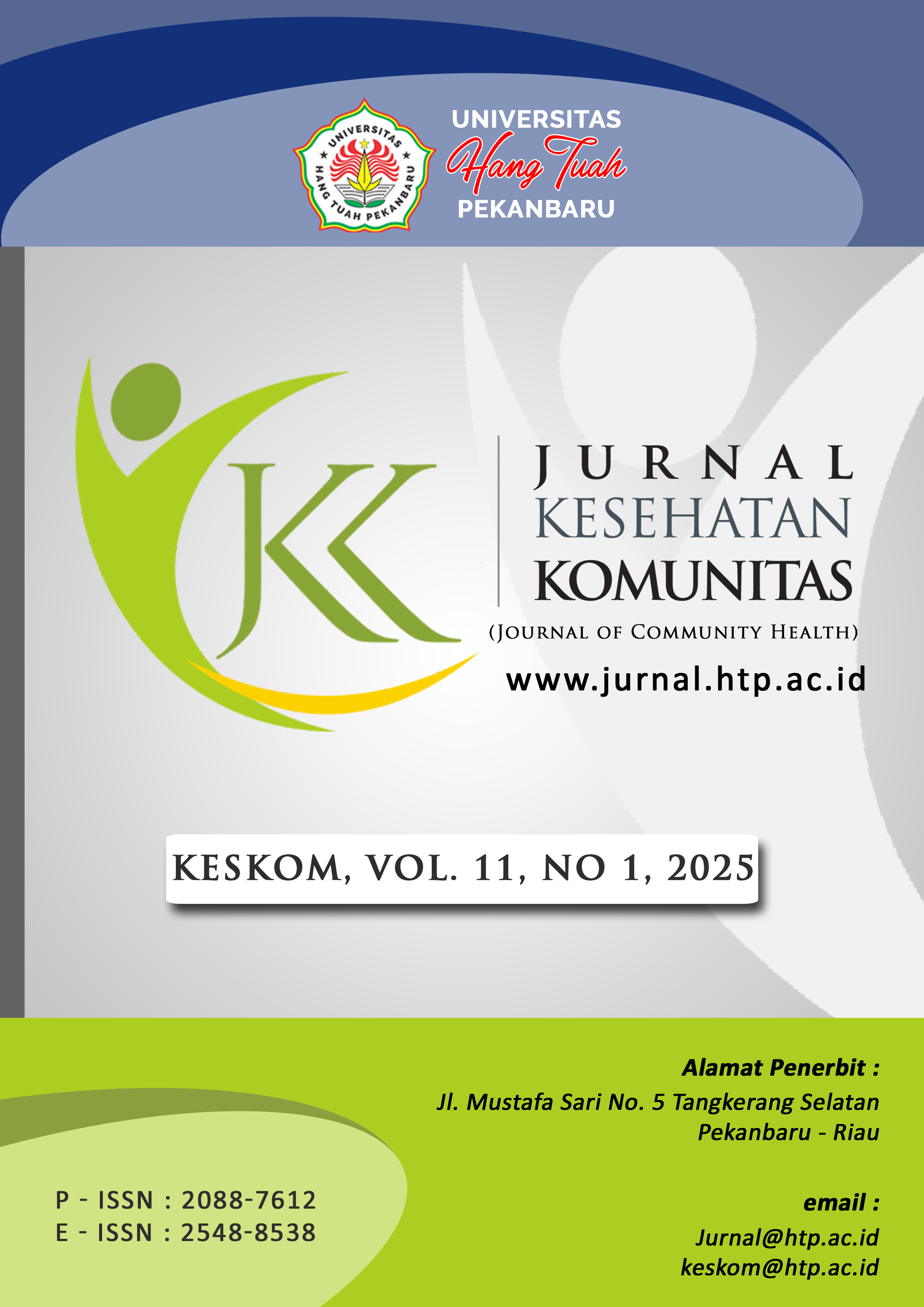Assessment of Electronic Medical Record Implementation Using HOT-FIT Method at Public Health Centers in Padang City
DOI:
https://doi.org/10.25311/keskom.Vol11.Iss1.2140Abstract
The implementation of Electronic Medical Records (EMR) in public health centers by December 31, 2023, as mandated by the Ministry of Health Regulation No. 24 of 2022, faces challenges in human, organizational, and technological aspects. This study evaluates the EMR system in public health centers in Padang using the HOT-FIT method through a mixed-method approach conducted from April to June 2024. Quantitative data were collected through a cross-sectional survey of 72 respondents (doctors, medical record staff, nurses) and qualitative data from 48 informants (heads of health centers, medical record staff). The findings indicate that in the human aspect, system usage was rated good (54.2%), but user satisfaction was low (58.3%). Organizational aspects, including structure (52.8%) and environment (54.2%), were rated good. In the technology aspect, system quality (51.4%) and information quality (56.9%) were rated poor, while service quality was rated good (62.5%). The net benefit aspect (55.6%) highlighted EMR's contribution to improving work efficiency and effectiveness. Challenges include insufficient training, low technological literacy, network disruptions, inadequate infrastructure, weak patient data security, and incomplete patient records. The study recommends the development of a mayoral regulation to address these challenges and enhance EMR implementation in Padang.
Downloads
References
[1] Ahmed MH, Bogale AD, Tilahun B, Kalayou MH, Klein J, Mengiste SA, et al. Intention to use electronic medical record and its predictors among health care providers at referral hospitals, north-West Ethiopia, 2019: Using unified theory of acceptance and use technology 2(UTAUT2) model. BMC Med Inform Decis Mak. 2020; 20(1): 1–11. doi : 10.1186/s12911-020-01222-x.
[2] Kementerian Kesehatan RI. Rencana Strategik Kementerian Kesehatan RI 2020-2024.
[3] Kementerian Kesehatan RI. Permenkes Noor 24 Tahun 2022 tentang Rekam Medis.
[4] Deharja A, Santi MW, Damayanti NA, Hargono A, Nandini N. Evaluating The Usability of Hospital Information System (HIS) Through Human Organization Technology-Fit (Hot-Fit) Model. Int Proc 2nd Int Sci Meet Heal Inf Manag 2020. 2020;5(1171):380–9.
[5] Deharja A, Waskito DY, Rachmawati E, Vestine V. Electronic Medical Records Implementation at Soeradji Tirtonegoro Hospital, Klaten, Indonesia. Unnes J Public Heal. 2023;12(2):104–15. https://doi.org/10.15294/ujph.v12i2.67972.
[6] Nurdiyansyah AK, Natalia AD, Sevtiyani I. Literature review analysis of application of electronic medical records in hospitals. Media Ilmu Kesehat. 2023;11(2):198–207. https://doi.org/10.30989/mik.v11i2.838.
[7] Sudirahayu I, Harjoko A. Analysis of Readiness for Implementing Electronic Medical Records Using DOQ-IT at RSUD Dr. H. Abdul Moeloek Lampung. J Inf Syst Public Heal. 2017;1(3):35–43. https://doi.org/10.22146/jisph.6536.
[8] Lakhmudien, Indradi R, Nugraha E, Setiyono IA. Pemahaman perekam medis terhadap penerapan rekam medis elektronik berbasis Permenkes Nomor 24 Tahun 2022. J Cakrawala Ilm. 2023;2(9):1–14. https://doi.org/10.53625/jcijurnalcakrawalailmiah.v2i9.5803.
[9] Putra DNGWM, Putri DNR, Ghibran R Al, Kinanti AS. Implementation Barrier of Hospital Management Information Systems and Electronic Medical Records in East Java. Hum Care J. 2024;9(2):421–38. http://dx.doi.org/10.32883/hcj.v9i2.3079.
[10] Rahmatiqa C, Werman W, Arrazy M, Abdillah N. Security and Confidentiality of Medical Record Data in Hospitals in the Use of Electronic Medical Records: Literature Review. J Med Rec Infomation Technol. 2023;1(1):11–8.
[11] Sibuea GHC, Napitupulu TA, Condrobimo AR. An evaluation of information system using HOT-FIT model: A case study of a hospital information system. Proc 2017 Int Conf Inf Manag Technol ICIMTech 2017. 2017;2018-Janua(November):106–11.
[12] Franki IS. Evaluasi Rekam Medis Elektronik dengan Metode HOT-fit di Klinik Saraf RS Mitra Plumbon. J Penelit Kesehat Suara Forikes. 2022;13(1):43–51. http://dx.doi.org/10.33846/sf.v13i1.1567.
[13] Mulyana M, Situmorang M, Fatikasari S. Evaluasi Sistem Informasi (Electronic Medical Record) Dengan Metode Hot-Fit Terhadap Mutu Pelayanan Kesehatan Di Rumah Sakit X Tahun 2023. War Dharmawangsa. 2023;17(4):1580–99. https://doi.org/10.46576/wdw.v17i4.3809.
[14] Siswati S, Ernawati T, Khairunnisa M. Analisis tantangan kesiapan implementasi rekam medis elektronik di Puskesmas Kota Padang. J Kesehat Vokasional. 2024;9(1):01–15. https://doi.org/10.22146/jkesvo.92719.
[15] Wirajaya MKM, Dewi NMUK. Analysis of the readiness of the dharma kerti tabanan hospital to implement electronic medical records. J Kesehat Vokasional. 2020;5(1):1. https://doi.org/10.22146/jkesvo.53017.
[16] Afrizal SH, Hidayanti AN, Handayani PW, Budiharsana M, Eryando T. Narrative Review for Exploring Barriers to Readiness of Electronic Health Record Implementation in Primary Health Care. Healthc Inform Res. 2019;25(3):141–52. doi : 10.4258/hir.2019.25.3.141.
[17] Hamamura FD, Withy K, Hughes K. Identifying Barriers in the use of electronic health records in Hawai’i. Hawaii J Med Public Health. 2017;76(3):28–35
[18] O’Donnell A, Kaner E, Shaw C, Haighton C. Primary care physicians’ attitudes to the adoption of electronic medical records: A systematic review and evidence synthesis using the clinical adoption framework. BMC Med Inform Decis Mak. 2018;18(1). doi: 10.1186/s12911-018-0703-x.
[19] Sucipto, Kuntoadi GB, Firmansyah MP, Lestari S, Utama T, Berliani P, et al. analisis penerapan rekam medis elektronik menggunakan metode Hot-Fit di Puskesmas Cireundeu. Prosiding SEMLITMAS Disem Penelit Pengabdi Masy. 2024;1(1):1–12.
[20] Ramoo V, Kamaruddin A, Nawawi WNFW, Che CC, Kavitha R. Nurses’ perception and satisfaction toward electronic medical record system. Florence Nightingale J Nurs. 2023;31(1):2–10. doi ; 10.5152/FNJN.2022.22061.
[21] Yusof MM, Arifin A. Towards an evaluation framework for laboratory information systems. J Infect Public Health. 2016;9(6):766–73. http://dx.doi.org/10.1016/j.jiph.2016.08.014
[22] Juliantari NK, Adiningsih LY, Putri PCS, Putra GW, Pradnyani PE. Gambaran proses implementasi rekam medis elektronik di unit rawat jalan dengan metode Hot-Fit di Rumah Sakit Umum Ari Canti. J Manag Inf Heal Technol. 2023;1(1):29–34
[23] Kementerian Kesehatan RI. Surat Edaran Nomor HK.02.01/MENKES/1030/2023 tentang Penyelenggaraan Rekam Medis Elektronik Kesehatan serta Penerapan Sanksi Administratif Dalam Rangka Pembinaan dan Pengawasan.
[24] Widayanti E, Septiana DH, Irmaningsih M, Putri VA, Budi SC. Kesiapan Puskesmas Samigaluh I dalam peralihan rekam medis konvensional ke rekam medis elektronik. J Manaj Inf Kesehat Indones. 2023;11(2):102–7. https://doi.org/10.33560/jmiki.v11i2.555.
[25] Sofia S, Ardianto ET, Muna N, Sabran S. Analisis aspek keamanan informasi data pasien pada penerapan RME di fasilitas kesehatan. J Rekam Med Manaj Inf Kesehat. 2022;1(2):94–103. https://doi.org/10.47134/rmik.v1i2.29.
[26] Siswanti, Dwi J. Tinjauan pelaksanaan rekam medis elektronik rawat jalan di Rumah Sakit Pelabuhan Jakarta. J Forum Ilm. 2017;14(2):171–181.
[27] Ananda SA, Ulfah A. Faktor Penghambat Pelaksanaan Pengisian Rekam Medis Elektronik Terhadap Kinerja Pegawai di Kamar Bedah RS Mata Cicendo. Media Bina Ilm. 2024;19(3):4009–14.
Downloads
Submitted
Accepted
Published
How to Cite
Issue
Section
License
Copyright (c) 2025 Jurnal kesehatan komunitas (Journal of community health)

This work is licensed under a Creative Commons Attribution-NonCommercial-ShareAlike 4.0 International License.
Copyright @2017. This is an open-access article distributed under the terms of the Creative Commons Attribution-NonCommercial-ShareAlike 4.0 International License (http://creativecommons.org/licenses/by-nc-sa/4.0/) which permits unrestricted non-commercial used, distribution and reproduction in any medium












































